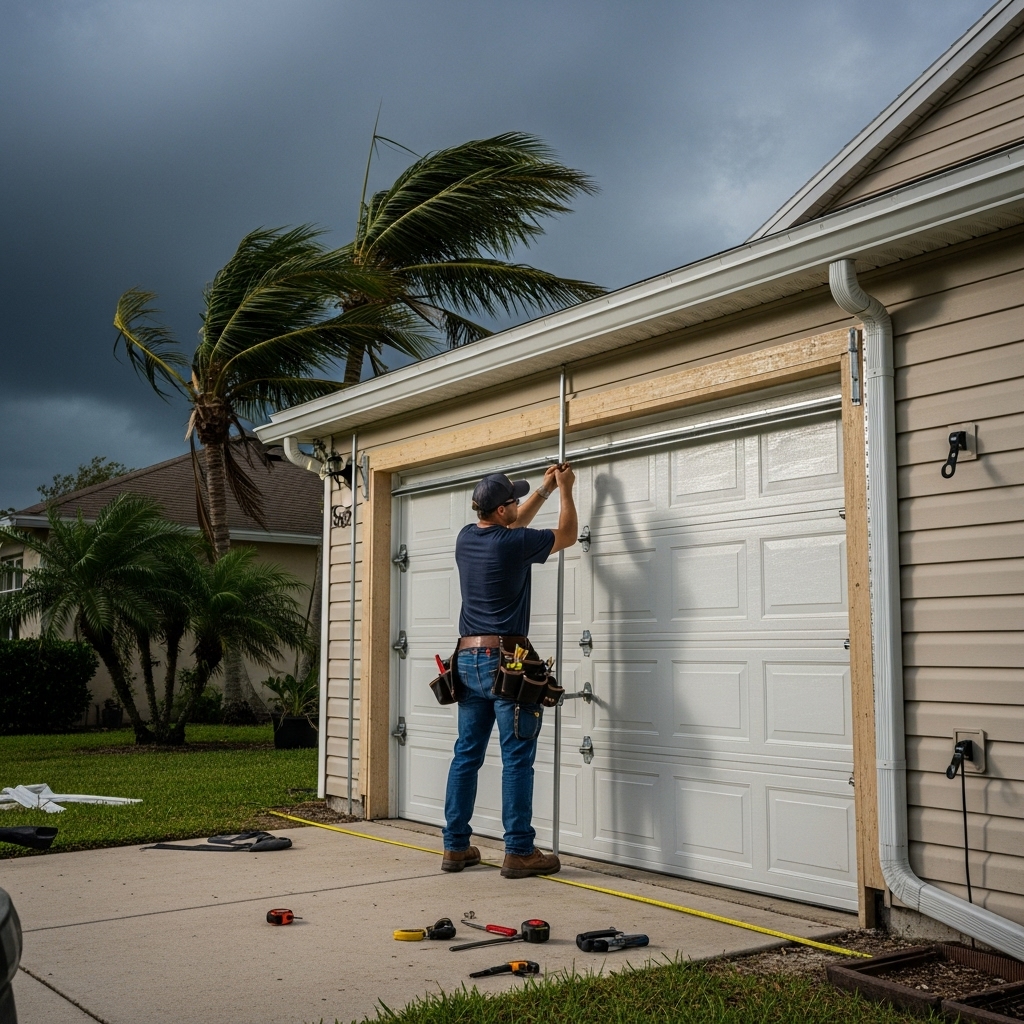Florida Hurricane Season Garage Door Maintenance That Stands Up to the Storm
Hurricane season brings powerful winds, wind-driven rain, and flying debris that test every part of your home—especially the garage door, which is often the largest opening. Preparing this system properly can prevent catastrophic failures, protect your vehicles and storage, and preserve your home’s structural integrity when the forecast turns serious. A focused maintenance plan tailored to Florida’s codes and weather patterns gives you confidence long before the first bands arrive. When you’re ready to prepare with expert hands, schedule a Florida-tested garage door service that prioritizes safety, strength, and reliability under pressure.
Many Florida homes feature impact-rated or wind-load-compliant doors, but even the strongest assembly needs correct installation, ongoing maintenance, and periodic verification to perform as designed. Seals harden, fasteners loosen, and reinforcements can go out of tolerance over time. Routine pre-season checks ensure your door remains balanced, reinforced, and able to close tightly—so it’s less likely to deform under pressure or blow out when winds surge.
Why Garage Door Readiness Matters
When a garage door fails in a storm, pressure rapidly equalizes through the opening, destabilizing the roof and walls. A well-maintained, properly reinforced door resists these forces far better than one with worn hardware or gaps along the perimeter. Florida’s codes reflect hard lessons learned from past storms: reinforcement struts, upgraded tracks, heavy-duty hardware, and correct anchoring make a measurable difference. A targeted maintenance service confirms that your door, opener, and safety systems are aligned with these standards and ready to perform.
Pre-Season Inspection Checklist
Before the season peaks, a thorough inspection uncovers vulnerabilities and sets a plan for reinforcement and repair. The most effective maintenance programs follow a detailed, methodical checklist and document findings for easy reference throughout the season.
- Balance and spring condition: confirm the door stays in place when halfway open and adjust or replace components as needed.
- Tracks and fasteners: check for bends, corrosion, or loosened anchors; upgrade hardware where appropriate.
- Reinforcement struts and brackets: verify fitment and add struts if the door flexes under manual pressure.
- Hinges, rollers, and bearings: replace worn parts to reduce vibration and promote smooth, secure travel.
- Bottom seal and perimeter weatherstripping: ensure tight contact to reduce water intrusion and wind-driven debris.
- Opener force and limits: calibrate so the door closes firmly without excessive pressure and reverses correctly.
- Manual operation and emergency release: confirm you can open the door safely if power is lost.
Wind-Load and Impact Considerations
Florida’s building codes specify wind-load requirements by region. Doors are rated based on their ability to resist specific pressures and impacts. Maintenance helps the installed door maintain its rating by making sure reinforcement and anchoring remain intact. Struts should be properly distributed, end stiles secured, and track brackets firmly attached to structural framing—not just drywall or thin furring strips. For impact-rated assemblies, edge alignment and locking mechanisms must operate smoothly to maintain structural performance.
Common Weak Points and How We Address Them
Small weaknesses become big problems under storm conditions. Corroded fasteners can shear, out-of-square tracks can bind, and brittle seals allow wind and water to pressurize the garage. Addressing these before the season improves both resilience and everyday performance.
- Corrosion control: swap rust-prone hardware for coated or stainless fasteners where suitable.
- Track reinforcement: install additional brackets, heavier gauge tracks, and better anchors where necessary.
- Strut upgrades: add or reposition struts to reduce panel flex and maintain door shape under load.
- Seal replacement: fit fresh bottom rubber and perimeter seals to block driven rain.
- Hinge and roller refresh: upgrade to heavy-duty components that tolerate side-load better during gusts.
Storm Mode for Openers
While the door’s structure bears the brunt of the wind, the opener plays a key role in reliable closing and post-storm operation. A calibrated opener ensures the door seals evenly without straining. Battery backup keeps access available when power fails, and smart controls allow status checks without opening the door in unsafe conditions. During maintenance, opener limits and force settings are fine-tuned, and all safety systems are validated to avoid nuisance reversals during weather events.
Preparing for Evacuation or Extended Outages
If evacuation is likely, your garage door should be easy to secure and verify. That means quick visual cues for locked positions, clearly labeled manual release, and confidence that the door is balanced enough to move by hand if the opener becomes unavailable. After a storm, a safe re-entry procedure prevents damage when debris is present or if the door has shifted. Maintenance includes a walkthrough of these steps with you or a family member.
Mid-Season Checks After Early Storms
Early-season squalls can loosen brackets or accelerate wear. A quick post-storm inspection confirms that reinforcement remains tight and the door closes evenly. This is especially important if the door took minor impacts from bins, bicycles, or shifting items inside the garage during winds. Catching these early avoids surprises when a stronger system moves through later in the season.
Water Intrusion and Sealing
Water seeks the easiest path. Even a small gap at the bottom seal can allow significant intrusion under pressure. Florida homes benefit from properly profiled bottom seals that match the floor, along with tight side and top seals that maintain contact. During maintenance, technicians identify uneven slabs, low spots, or bowed sections and offer solutions such as new seals or track adjustments that improve contact and reduce infiltration.
Homeowner Tips for Ongoing Readiness
Between professional visits, a few simple routines help keep your door storm-ready. The goal is not to replace professional maintenance but to reinforce it with observant, low-risk steps that reduce surprises.
- Listen monthly for new rattles, squeaks, or grinding that indicate loose or worn components.
- Keep tracks free of clutter and avoid leaning items against the door or rails.
- Wipe photo eyes and ensure they are aligned to prevent nuisance reversals.
- Inspect seals and replace them when they become brittle or cracked.
- Test manual operation with the opener disengaged to confirm reasonable balance.
FAQ
Q: Do I need an impact-rated door to be prepared?
A: Many Florida homes use impact-rated or wind-load-compliant doors. If your current door isn’t rated, reinforcement and maintenance still improve performance, but consider discussing upgrades aligned with your region’s requirements.
Q: How often should I schedule hurricane-focused maintenance?
A: A dedicated pre-season visit is ideal, with a post-storm check if your area takes a direct hit or you notice changes in operation.
Q: Will reinforcement make my door harder to operate?
A: Properly installed struts and reinforcements should not make the door difficult to move. Balanced springs and tuned opener settings keep operation smooth.
Q: Can I tape or brace the door myself before a storm?
A: Temporary DIY measures rarely provide meaningful strength and may interfere with safe operation. Professionally installed reinforcements are the safest and most effective approach.
Q: What should I do if the door is damaged during a storm?
A: Do not operate a visibly damaged door. Secure the area and schedule an inspection to prevent further harm to the opener or structural components.
Q: Are seals really that important?
A: Yes. Tight seals reduce wind pressure inside the garage and help keep out water and debris, which protects belongings and the door system itself.
Strengthen Your Home Before the Next Storm
Preparedness is peace of mind. Give your home the advantage of a door that’s balanced, reinforced, and sealed against Florida’s fiercest weather. Schedule expert, Florida-focused garage door service and face hurricane season with confidence that your largest opening is ready for what comes.

